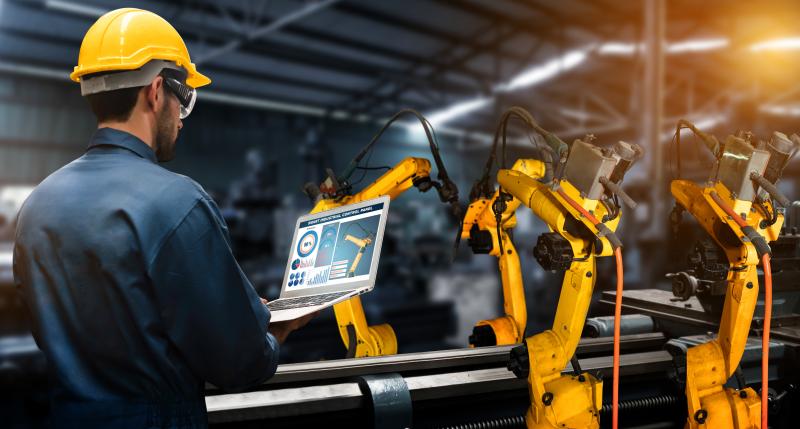Workplace & Safety Practices for Automation?
Industrial automation technology has earned a spot in the annals of history as being the driving force in unprecedented levels of productivity, efficiency, and quality. Perhaps automation’s greatest contribution, however, has been advancements in worker safety, which has seen commensurate progress the more widely adopted automation technologies become.
In this article, we’ll examine the relationship between automation technologies and workplace safety.
How Human Workers Benefit from Automation
Though the benefits are many (and could rightly be summarised in an article all on its own), we’ll do our best to extol the virtues of automation’s impact on worker safety in a general sense.
In most factories where automation is present, robotics and other automation technologies are used to replace workers in roles that pose an elevated risk of workplace injury. That is to say, the types of jobs that perhaps require frequent repetitive movements, those performed in harsh conditions, or those located in dangerous environments. Of course, the environment of a task does not need to be inherently dangerous in order for workplace injuries to occur; just about any production line that you come across contains a degree of risk of injury. Robotics and automation can help to alleviate these risks as well. Depending on the application, these advanced technologies could mean that fewer human workers are physically required to work the line, resulting in a quantifiable decrease in workplace injuries. In cases where repetitive motion injuries are an issue, the implementation of robotics and automation could mean that the human workers that are required to work the line can perform those tasks for a shorter period. In either case, drawing a correlation between the prevalence of robotics and automation in a factory and a reduction in lost time injuries is not a difficult conclusion to come to.
Logic, anecdotal evidence, and common sense aside, there are irrefutable findings that show that by implementing automation technology an employer can expect to observe a reduction in three of the five leading causes of workplace injuries. These include contact with harmful materials, lifting heavy objects, and repetitive stress injuries.
While it goes without saying that employees directly benefit from remaining healthy on the job, it is perhaps less obvious that the benefit to employers is equally great. According to the National Safety Council, (NSC), the total cost of work-related injuries reported in 2017 was in excess of $160 billion; a figure that not only reflects employee lost time compensation, but also losses to the company in terms of reduced productivity. While an injured worker can be replaced in the short term, bringing a new employee up to speed for a specific role takes both time and money.

How to Prevent Worker Apathy or Complacency in the Face of Automation?
One thing that automation or robotics cannot improve right off the bat, is the degree of apathy or complacency some workers may develop. While there is no denying that automation – whether at a system level or at a worker level – promotes a greater degree of safety up and down the production line, allowing a false sense of security to run rampant can introduce new hazards. It’s also worth noting that while the use of a term like “complacency” carries with a negative connotation, worker complacency in the presence of automation is not necessarily something that occurs deliberately. For example, a worker’s lack of experience or understanding of the robotics or automation tools used may cause them to pay less attention to the dangers that surround them.
This is not something that should be considered breaking news; OSHA (Occupational Safety and Health Administration) came to the conclusion three decades ago that automation is not without risk. To put a finer emphasis on that point, Automated processes have a habit of altering the behaviour of human workers in ways that cannot always be foreseen. What this means is that employers, industries, and regulation bodies need to pay close attention to how workers are interacting with automation technology and continue to push the ball down the field in terms of creating the kinds of safety standards that can be quickly adapted to evolving technologies. Much of the danger associated with automation can be reduced by mitigating employee complacency (i.e., the unjustified belief that an automation system always performs optimally), which in turn means investing in adequate training for all employees working with and around the devices in question.
Robots and Workplace Safety Guidelines
Robotic technology always seems to be so cutting edge – for lack of a better term – that it is easy to forget that automation technologies have been around for the better part of 30 years. And while some aspects of the technology may be older than the operators that work alongside them, the speed at which the technology evolves leaves most of us feeling it is still very well in its infancy. This rapid growth makes regulation and the development of a set of universally-accepted safety standards difficult.
In most jurisdictions, federal or national laws govern how citizens, and the environment are protected. This means that standards can range wildly from one country to the next due, due to different factors that are too many in number to go into here. Having said that, the International Society of Automation (ISA) is the preeminent certification and standardisation body for automation and control processes. This means that no matter how different country A may be from country B in terms of values, culture, etc., the acceptance of ISA signifies that automation professionals in either country can work towards a standard level of accreditation in their respective fields. Not only has the American National Standards Institute (ANSI) accredited the ISA with the development of automation standards, but it also publishes standards through the International Electrotechnical Commission (IEC).
Automation Technology Bolsters Workplace Safety
Even though automation’s main goal is to improve productivity, it also provides an intrinsic value in terms of promoting working conditions for human workers. As technologies continue to evolve, it is reasonable to assume that safety will continue to be a beneficiary of widespread adoption. It is important to remember however that technology alone does not guarantee safety; employee training and adherence to international standards are also of critical importance. If you would like to learn more about robotics, automation, and more, contact George Brown College today.
Comments
The average completion time…
Submitted by Iris on Mon, 02/06/2023 - 08:07
The average completion time is approximately 32 weeks of part-time study. The program’s flexible computer-based modules are designed to fit into your schedule, not ours, so you can work at your own pace to complete the program.

How long does the program take to complete?